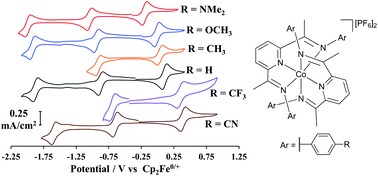The structure and electrochemical properties of a series of bis(imino)pyridine CoII complexes (NNN)CoX2 and [(NNN)2Co][PF6]2 (NNN = 2,6-bis[1-(4-R-phenylimino)ethyl]pyridine, with R = CN, CF3, H, CH3, OCH3, N(CH3)2; NNN = 2,6-bis[1-(2,6-(iPr)2-phenylimino)ethyl]pyridine and X = Cl, Br) were studied using a combination of electrochemical and theoretical methods. Cyclic voltammetry measurements and DFT/B3LYP calculations suggest that in solution (NNN)CoCl2 complexes exist in equilibrium with disproportionation products [(NNN)2Co]2+ [CoCl4]2− with the position of the equilibrium heavily influenced by both the solvent polarity and the steric and electronic properties of the bis(imino)pyridine ligands. In strong polar solvents (e.g., CH3CN or H2O) or with electron donating substituents (R = OCH3 or N(CH3)2) the equilibrium is shifted and only oxidation of the charged products [(NNN)2Co]2+ and [CoCl4]2− is observed. Conversely, in nonpolar organic solvents such as CH2Cl2 or with electron withdrawing substituents (R = CN or CF3), disproportionation is suppressed and oxidation of the (NNN)CoCl2 complexes leads to 18e− CoIII complexes stabilized by coordination of a solvent moiety. In addition, the [(NNN)2Co][PF6]2 complexes exhibit reversible CoII/III oxidation potentials that are strongly dependent on the electron withdrawing/donating nature of the N-aryl substituents, spanning nearly 750 mV in acetonitrile. The resulting insight on the regulation of redox properties of a series of bis(imino)pyridine cobalt(II) complexes should be particularly valuable to tune suitable conditions for reactivity.
